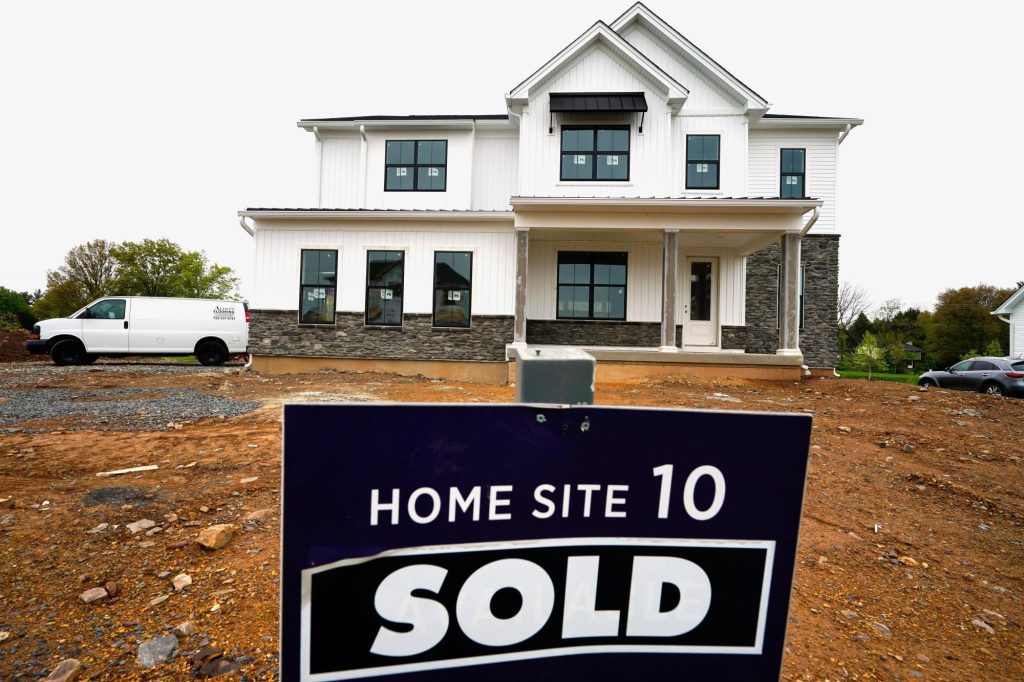By JOSH BOAK (Associated Press)
Lori Shelton can’t imagine ever having enough money to buy a home, which is a major reason why many voters feel negative about the economy before this year’s presidential election.
Shelton, 67, works as an Uber driver to help pay rent in Aurora, Colorado. An advance on her pay covered her apartment’s security deposit, but it also reduced her next paycheck, leaving her bank account dangerously low when the rent was due — a cycle that never seems to end.
“I’m always one step behind,” said Shelton, her voice choking up. “It’s a nightmare, it’s a freaking nightmare right now.”
The United States is struggling with a housing affordability crisis that has been developing for decades. housing affordability crisis that was decades in the making. At the root of this problem: America failed to build enough homes for its growing population. The shortage strikes at the heart of the American dream of homeownership — dampening President Joe Biden’s assurances that the U.S. economy is strong and underscoring the degree to which Republican Donald Trump, the former president and presumptive GOP nominee for 2024, has largely overlooked the shortage. The lack of housing has caused a record number of renters to devote an excessive amount of income to housing, according to a Harvard University analysis. Not enough homes are for sale or being built, keeping prices elevated. Average mortgage rates have more than doubled and further worsened affordability.In fact, the Census Bureau reported that homeownership fell slightly at the end of last year in an otherwise solid economy. If it wasn’t for shelter costs, inflation — Biden’s most pronounced economic problem — would be running at a healthy and stable 1.8%. Instead, it’s hovering around 3.2%.
Administration officials are confident that shelter inflation will soon cool, but the damage across several years is apparent to advocates and economists. “I’ve been doing housing work for 30 years — the housing affordability challenge is the worst I’ve ever seen in my career,” said Shaun Donovan, a former secretary of Housing and Urban Development in the Obama years who now leads the nonprofit Enterprise Community Partners.Donovan noted that this is an increasingly bipartisan challenge that could bring the political parties together. Expensive housing was once the domain of Democratic areas such as New York City and San Francisco. It’s now moved into Republican states as places such as Boise, Idaho, grapple with higher prices.
“It is a first-tier issue almost everywhere,” he said. “And that is changing the national politics around it in a way that I think is quite different than I’ve ever seen.”
Mark Zandi, chief economist at Moody’s Analytics, said that the outcome of the November election could ultimately depend on the path of 30-year mortgage rates.
Rates currently average about 6.74%.
If they dropped closer to 6%, the odds of a Biden victory would increase. But rates moving near 8% might enable Trump to prevail, Zandi said.
“Given the current housing affordability crisis, higher rates will make owning a home completely out of reach for nearly all potential first-time homebuyers,” he said. “Since homeownership is a key part of the American dream, if it appears unattainable, this will deeply impact voters’ sense of the economy.”
Biden, a member of the Democratic Party, acknowledged the suffering many people are experiencing in his State of the Union speech earlier this month and in his budget plan released on Monday.
The president aims to finance the construction and preservation of 2 million housing units — a significant amount, but not sufficient to solve the shortage. He also suggested a tax credit valued up to $10,000 for homebuyers. Over the last three years, he has increased rental aid to 100,000 households. In a speech to the National League of Cities on Monday, Biden stated, “Simply put, we have to construct, construct, construct. That’s how we permanently lower housing costs.”
Escalating home prices were also a persistent issue during Trump's presidency, when he gained fame as a real estate developer. As president, Trump advocated for limiting construction in suburban areas. During the 2020 election, he claimed that Biden’s policies to encourage construction and affordability would “ruin your neighborhood.”
During the 2018 to 2020 period of Trump’s presidency, the country’s housing shortage increased by 52% to 3.8 million units, according to the mortgage company Freddie Mac.
The Associated Press reached out to Trump’s campaign for his policy plans but did not receive a response. The America First Policy Institute, a think tank promoting Trump’s vision, stated that the key is to reduce government borrowing to lower mortgage rates. The former president has pledged to decrease deficits, but an analysis by the Committee for a Responsible Federal Budget shows that his policies in office will likely have added more than $8 trillion to the national debt.
“The most effective way for us to enhance access to homeownership for young individuals is to bring interest rates back down, not to offer subsidies that worsen housing unaffordability,” said Mike Faulkender, chief economist at the institute.
Decreased rates may be popular with voters, but most economists argue that they would at most provide temporary financial relief. Purchase prices would probably increase in response to higher demand caused by declining rates.
Lower rates might be well-received by voters, but most economists say they would only offer short-term financial relief at best. Prices for purchasing homes would likely adjust upward due to increased demand as a result of falling rates.
Construction, being the more lasting solution, would take years to accomplish and necessitate new regulations by states and cities. The administration is attempting to encourage zoning changes, but the major decisions are beyond the White House's authority. new rules by states and cities
. The administration is trying to incentivize zoning changes, but the major choices are outside the White House’s control.
“Even as incomes are rising, the economy is thriving, and inflation is decreasing, people are unable to purchase homes,” said Daryl Fairweather, chief economist at the brokerage Redfin. “That’s the biggest issue for Biden because it’s not one that he can resolve.”
The general guideline is that individuals should spend no more than 30% of their income on rent or a mortgage. A typical household seeking to buy a home would have to allocate 41% of its income to mortgage payments, as per Redfin. As a result, there are extensive economic risks. High housing expenses can lead individuals to reduce spending in other areas. Advocates mentioned that it allows landlords to disregard their properties since there is always a tenant available.Evictions can exacerbate health and educational outcomes for children and have a broader negative impact on society, as stated by Zach Neumann, a lawyer based in Denver who offers over $30 million in rental aid annually through the nonprofit Community Economic Defense Project.
Neumann said that evicting poorer renters costs about $20,000 to $30,000 per year, considering shelter nights and emergency room visits. He finds it overwhelming to think about the total numbers and sees renters fighting to have a roof over their heads.
Both parties agree on the need for more housing, but there hasn't been a significant plan passed by the House and Senate yet. Biden has proposed housing aid throughout his term, but it never became a reality.
Daniel Hornung, deputy director of the White House National Economic Council, mentioned that if Congress had passed some of the investments that the president has called for since the beginning of the administration, affordable units would be available now.
Mark Calabria, the former director of the Federal Housing Finance Agency during the Trump administration, expressed concerns that federal tools to increase housing, like the Low-Income Housing Tax Credit, could further increase demand without enough construction.
Calabria, now an adviser with the libertarian Cato Institute, worries that the focus on increasing demand is misguided, as the real issue is the lack of supply.
Lori Shelton in Colorado is a renter who doesn't find comfort in the debate about adding housing supply, as she's currently behind on rent and has faced eviction threats and late fees. She receives some rent money from her son and has also relied on her church at times to cover the $2,399 a month.
Shelton mentioned that most of the renters like her don't have savings accounts. She explained that when you spend a lot on rent, groceries, car, and bills, there's not much left for emergencies.
The housing shortage is making President Joe Biden's assurances about the strength of the U.S. economy less convincing.
“My worry would be we’ve done a number of things that increased demand when the problem is supply,” said Calabria, now an adviser with the libertarian Cato Institute.
But for renters such as Lori Shelton in Colorado, the debate about how to add housing supply is cold comfort when she owes rent now. She’s previously dealt with the threat of eviction and late fees. She gets some rent money from her son, but she has also relied at times on her church to cover the $2,399 a month.
“I don’t think the majority of us have that savings account,” she said. “If you spend that much on your rent and your groceries and your car and your bills, you don’t have much for a fallback.”









